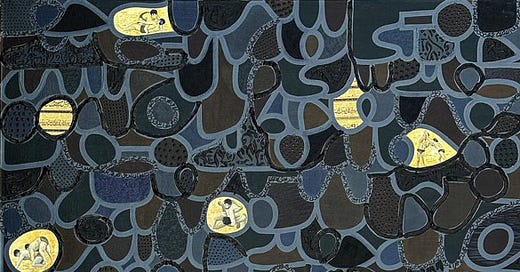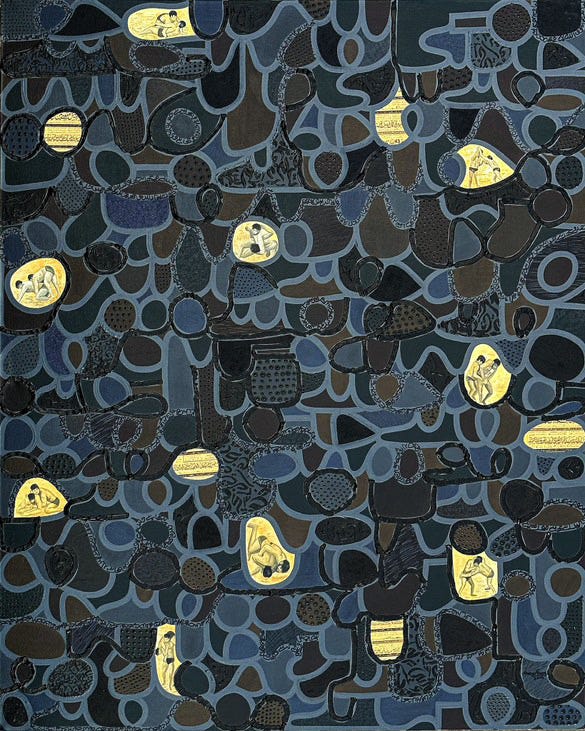Beneath the Surface: Navigating Identity, Tradition, and Change in Contemporary Pakistani Art
Artwork of the month
In the rapidly evolving landscape of South Asian contemporary art, Ahmer Farooq represents an intriguing emerging voice whose work "Beneath the Surface" (2023) demonstrates remarkable potential. This piece showcases his sophisticated approach to addressing complex social narratives through traditional visual vocabulary, positioning him as one of Pakistan's most promising contemporary artists to watch.
Visual Analysis
The work's intricate composition - a dark tapestry of overlapping forms punctuated by illuminated vignettes - demonstrates remarkable technical sophistication. At first glance, the viewer encounters a mesmerizing pattern of interlocking shapes in deep blues and blacks, creating a complex lattice that seems to pulse with organic energy. This intricate background serves as camouflage and framework for the piece's true protagonists: golden medallions containing images of traditional Pakistani wrestlers, or Pehalwans, rendered with delicate precision.
The sophisticated layering technique recalls the complexity of traditional miniature paintings, where multiple narratives often coexist within a single frame. The dark, maze-like pattern creates a sense of depth beyond mere physical space - it suggests the layers of society, tradition, and personal identity that his subjects must navigate.
The color palette in "Beneath the Surface" is particularly significant. The use of dark blues and blacks creates a nocturnal atmosphere, suggesting concealment and protection. Against this darkness, the golden vignettes glow like secrets finally brought to light or perhaps like memories preserved in amber. This interplay between light and shadow becomes a powerful metaphor for navigating multiple identities in contemporary society.
Cultural Context and Symbolic Significance
Farooq's choice of Pehalwans as subject matter is particularly intriguing in this context. Traditional wrestling is revered in South Asian culture, where physical contact between athletes is accepted and celebrated. This acceptance creates an interesting dialogue with other social contexts in conservative Islamic society, offering a subtle but significant commentary on cultural norms and personal identities.
The artist's integration of Urdu calligraphy adds another layer of complexity, creating a multi-layered narrative that speaks to the intersection of tradition and modernity. These textual elements, woven seamlessly into the composition, carry coded messages of love and resilience while maintaining traditional aesthetic values.
Philosophical Framework
The philosophical implications of "Beneath the Surface" are profound, mainly when considered through French philosopher Michel Foucault's concepts of power and visibility. The work explores what German philosopher Martin Heidegger might call the "unconcealment" of truth – the complex interplay between what is revealed and what remains hidden. Through this lens, the work becomes an aesthetic object and a meditation on existence itself.
Contemporary philosopher Judith Butler's theories about performativity and identity also provide an interesting framework for understanding this work. The repeated motifs and hidden narratives speak to the performative nature of identity in society, particularly in contexts where certain expressions of self must remain coded or concealed.
Artistic Context and Comparisons
Farooq's work can be viewed alongside other contemporary South Asian artists who explore similar themes of identity and tradition. Artists like Salman Toor and Shahzia Sikander have also addressed questions of cultural identity and personal authenticity in their work, though each approaches these themes through different visual strategies. While Toor's work often directly confronts questions of identity in Pakistani society, Farooq's approach is more subtle, using traditional motifs to create space for multiple interpretations.
Exhibition History and Evolution
Looking at Farooq's exhibition history, from his early shows at Al-Hamrah Art Gallery to his recent international exhibitions like "Devout Unorthodox" at FW Fine Art in Palm Beach (2020) and "A Safe Space" at Pakistan Art Forum (2023), we can trace the development of his artistic concerns. His work has consistently engaged with themes of tradition and contemporary identity but has grown increasingly sophisticated in its execution.
From an investment perspective, Farooq's trajectory is particularly noteworthy. His international presence is growing steadily, with recent exhibitions spanning from Palm Beach to Dubai, and his works are already finding homes in private collections across multiple continents. For collectors interested in emerging South Asian art, Farooq's work presents an opportunity to acquire pieces from an artist who skillfully bridges cultural traditions with contemporary dialogue.
What makes Farooq particularly interesting from a market perspective is his unique position at the intersection of multiple valuable trends in contemporary art: his work engages with identity politics, draws from traditional cultural elements, and demonstrates technical sophistication while maintaining conceptual depth.
For collectors and institutions looking to diversify their holdings with emerging South Asian art, Farooq's work offers a compelling entry point. His prices remain accessible relative to more established artists addressing similar themes, yet his technical skill and conceptual depth suggest significant potential for future appreciation.
"Beneath the Surface" ultimately succeeds as a commentary on specific social issues and as a broader meditation on the human experience of living with multiple identities in the contemporary world. It reminds us that beneath the surface of any society exist countless stories waiting to be acknowledged and understood, each as complex and worthy of consideration as the intricate patterns that populate Farooq's canvas.
More about Ahmer Farooq:






